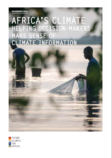February 8, 2017 — Climate change’s effects on humankind may prove most severe on the African continent, due to widespread poverty and unstable governance in many countries. Yet scientists and policy-makers on the continent suffer from a serious lack of access to climate science data. Future Climate for Africa aims to change the tide by conveying the latest scientific information to those who need it most as well as identifying knowledge gaps and filling them. In that vein, FCFA just published a new report that provides easy-to-digest fact sheets on climate trends and implications in various regions throughout the continent.
“Africa’s Climate: Helping Decision‑Makers Make Sense of Climate Information” compiles the latest science into 15 fact sheets. The first five fact sheets provide general climate information for central, east, southern and west Africa, with one additional fact sheet on southern Africa aimed at scientists. The next four fact sheets address “burning questions” related to climate science in the four regions. The report concludes with general reader-level fact sheets on six of the countries in which FCFA works: Malawi, Rwanda, Senegal, Tanzania, Uganda and Zambia.
 Central Africa: Due to lack of climate data, the central region is severely understudied. Few weather stations exist through the Congo Basin, for example. With the second largest carbon stock of any country, the Democratic Republic of Congo is critical to offsetting greenhouse gas emissions and mitigating climate change. Yet it’s difficult given the current state of the science to predict how climate will affect rainfall or how changes in rainfall will affect carbon stores in the country’s rainforests. Many people in Central Africa rely on rain-fed agriculture, so understanding rainfall changes will be critical to preventing harmful impacts on health and livelihoods.
Central Africa: Due to lack of climate data, the central region is severely understudied. Few weather stations exist through the Congo Basin, for example. With the second largest carbon stock of any country, the Democratic Republic of Congo is critical to offsetting greenhouse gas emissions and mitigating climate change. Yet it’s difficult given the current state of the science to predict how climate will affect rainfall or how changes in rainfall will affect carbon stores in the country’s rainforests. Many people in Central Africa rely on rain-fed agriculture, so understanding rainfall changes will be critical to preventing harmful impacts on health and livelihoods.
East Africa: Models show that East Africa will become hotter, with less predictable yet more intense rainfall, along with longer dry seasons in the coming decades. On the other hand, models sometimes provide conflicting and uncertain results, particularly with rainfall. Tropical Africa has two rainy seasons, “short rains” and “long rains,” interspersed with dry seasons. East Africa has experienced droughts during recent long rains seasons, yet models predict increasing rainfall in the decades ahead. Adaptation projects in this region will require flexibility so nations can respond to whatever changes actually occur. Floods are likely to affect sanitation in urban areas. Uganda relies on hydroelectric power and exports energy to Kenya, and will have to adapt to increased or decreased rainfall and address water release rules to hold more in high rainfall years.
Southern Africa: The subtropical area of southern Africa experiences four seasons and has a series of mountain ranges that influence weather. Oceans on either side of the region influence rainfall. Southern Africa is relatively well studied, with over 40 climate models simulating the next 5 to 50 years and some simulating up to 100 years. This fact sheet includes a primer on how climate simulations work and how they model uncertainty.
West Africa: People’s daily lives in the West Africa region are substantially affected by year-to-year climate variability, due to reliance on rain-fed agriculture and limited availability of clean water, among other things. The region has already experienced an average temperature rise of 1 °C (1.8 °F) since 1950, and in the Sahel average temperature has increased even more, mostly due to hotter nights. Climate models show increased temperatures, although predicted changes in rainfall vary among models.
Check out the full report here.
![]()
Ensia shares solutions-focused stories free of charge through our online magazine and partner media. That means audiences around the world have ready access to stories that can — and do — help them shape a better future. If you value our work, please show your support today.
Yes, I'll support Ensia!

Note Nicholas Kristof's NYTimes article about Mozambique. -BParker